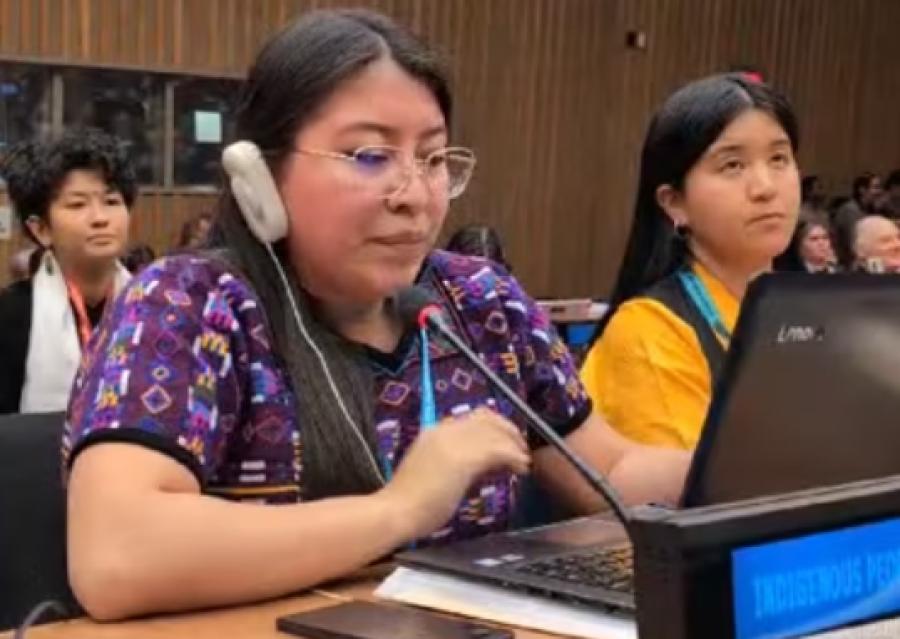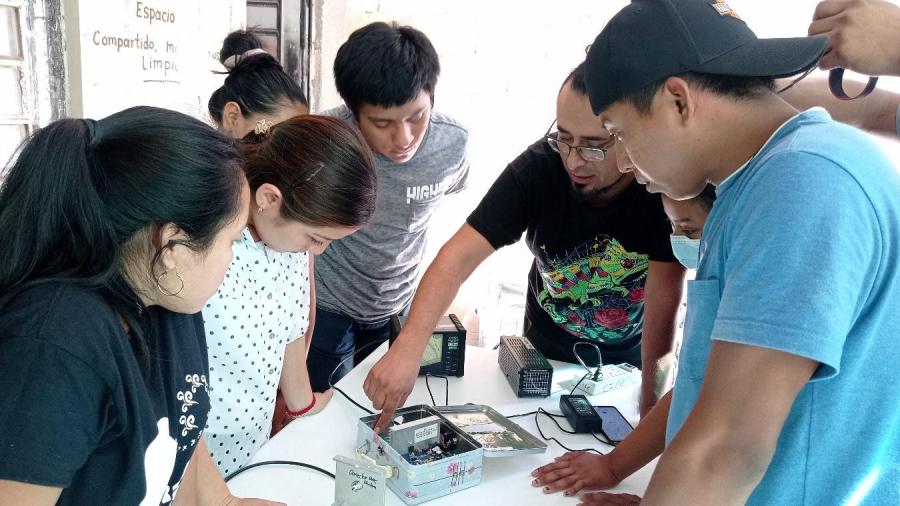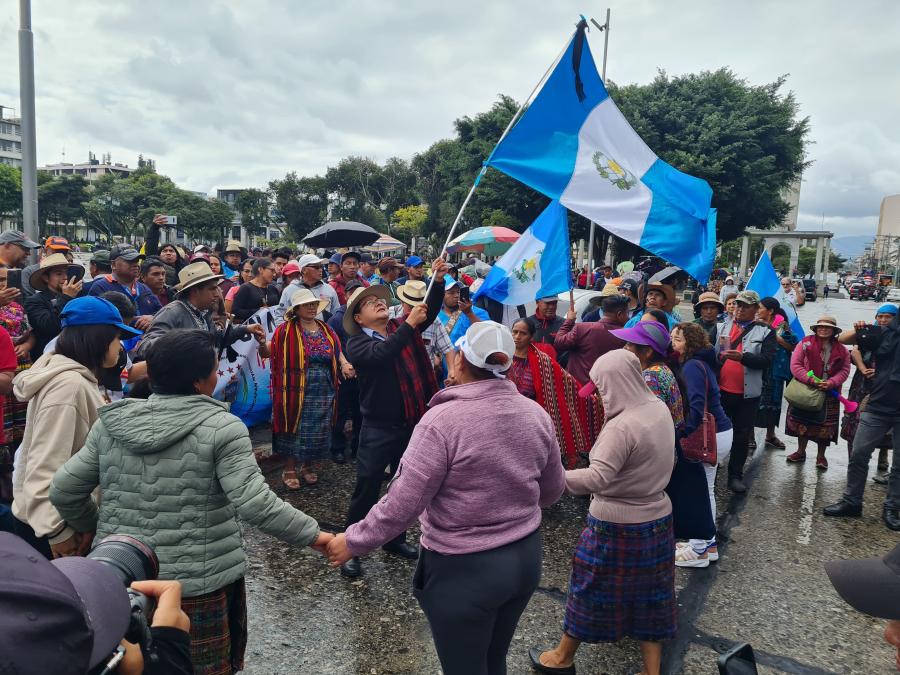A Mayan community shares stories of its struggle to avoid forced eviction by a nickel mine.
A Contested Land
It was the middle of May, just days into the rainy season when we made the trip to Lote 8, one of the dozens of Maya-Q’eqchi’ villages scattered within, and against, the steep and perennially green Sierra de Santa Cruz in far eastern Guatemala. Clouds built and dissipated over the Western Highlands, reaching the lowlands around Lake Izabal and the Polochic River basin in the falling dusk. Then the stagnant heat broke, in storm. In the weeks to come, the rains would increase, scouring the mountains of their red earth, forcing it to the valley below, and eventually out to sea.
Like numerous other Indigenous communities in the region, the residents of Lote 8 initially departed from the rich plain below at least a century ago, as the banana empire expanded. It’s hard to believe today that these lowlands, seemingly empty and desolate, were once the historic lands of the United Fruit Company, with orderly rows of short banana palms stretching as far as the eye could see. National decree dictated that the Maya-Q’eqchi’ of Izabal worked the fields— harvesting and cleaning the spaces between the trees—and bought from the company store. Those who opened their mouths in dissent were quickly silenced. The Indigenous people occupied the marginal lands, and many still live on the narrow sloping tracts beneath the mountain, within view of the sprawling lake and the distant mist-shrouded ridgelines of the Sierra de Las Minas to the south. Others, like those from Lote 8, fled deeper and higher into the mountains, took root, had years of flood and drought and plentiful harvests, and practiced the ancient ways.
But those from the north knew that the red earth meant mineral wealth—specifically nickel—that could be extracted, processed, and sold on a global market. During the civil war of the ’60s, ’70s, and ’80s, the World Bank sold a prescription of “poverty elimination” to Third World countries such as Guatemala, based on the principle that this land was better off in the hands of foreigners, and that the subsurface should be under their jurisdiction. Accordingly, the army generals signed over the surrounding lands—all 100 square miles of it, where they presumed the best ore lay beneath the tropical woods, rivers, and cornfields, to Canadian-owned INCO. The mine’s processing plant was built on Lake Izabal’s edge, and the town of El Estor (literally meaning, “the store”), a prominent, though dying, outpost from the United Fruit heyday, served as its base.
The span of operation was short—and tumultuous and deadly for those who lived on the land—and the ownership of concession and infrastructure passed through hands incestuously to maintain licenses that the original company, Canadian-owned INCO, purchased in 1965. Since then, ownership has shifted from INCO to Canadian-owned Skye Resources in 2004, and Hud Bay Minerals in 2008. The Guatemalan Nickel Company is the Guatemala subsidiary of both.
For the past 30 years, since the indefinite closure, the mine site has remained empty and rusting in the wet wind. But still, there are vast reserves of nickel ore scattered throughout, and as long as the potential for reopening exists, those who live within the concession land—the “illegal squatters” as stated by Hud Bay Minerals—must, and will, be removed, by any means necessary.
The Testimony
María Magdelena Cuc Choc, one of our interpreters, herself an active community member, helped frame the day to come. As the sister of jailed activist Ramiro Choc and sister-in-law of recently murdered Adolfo Ich Xaman, she explained her experiences of suffering at the hands of the mining industry. “We want these monsters out of here. We don’t care where they go,” she declared.
We prayed for early rain, or even just clouds to shade the sun. After riding in the back of a pickup truck, we climbed the rough pathways above the lake and river basin, beyond other settlements “illegally” occupying land flat enough to erect thatched-hut dwellings and plant corn. Ever since INCO sold the mine to Skye Resources in 2004 and the serious potential for mining arose again, the company’s tactics to clear out individuals and communities living within the concession have become more and more brutal and deceitful.
The original village of Lote 8, constructed in the mid-1950s, sat on an undulating ridge. Now we just found abandoned, overgrown roads, a fire-scarred tree, and mysterious holes left by company geologists. We traveled on foot for an hour on a well-marked path along the steep, densely forested mountainside to the new site. It was cool beneath the trees, with clear water flowing through every depression, abundant tropical birds like creepers and thrushes, and signs of mammals. The new village occupied a miniature basin, encircled with cardamom bushes toward the edge of the forest.
Perhaps 60 people—men, women, children, infants—quietly sat on rows of benches with faces peering west, awaiting our arrival. Dogs sought refuge from the unrelenting heat under the simple, open-air hut with a tin roof, perched on a small knoll that afforded views in all directions. Our group scattered toward the front, and, after brief introductions, a bit of clapping, and tense smiles, they began to tell us what had happened.
The first speaker, Raúl [all names have been changed for safety reasons], told us how, denied their land, Lote 8’s people were forced to live asrenters, sharecroppers in a way, living on a large finca whose owner eventually sold his estate to the mining company. Leaders were assassinated early on for demanding rights and legal ownership of the land. They spoke of ancient ties to this land, their mother, their bearer of corn and culture. They would defend her at all costs.
Raúl and the other men spoke of negotiations with the companies that were always sketchy: officials did not want to provide full documentation of yearly rent payments to the company of Q53,000 (about $6,000], which came in full, for over 40 years. Sometimes it appeared that Lote 8’s residents might win, that they would buy the land outright, but 2004 was a bad year for all Maya-Q’eqchi’ communities surrounding Izabal, they said. Economists and global markets hinted there might be a market for nickel after all, and soon enough, the global demand equaled the investment needed to reopen the plant in El Estor.
“It was on January 9, 2007 when they arrived,” Raúl told us: hundreds of national police, Guatemalan military soldiers, and the company’s private security forces. “They gave us five minutes to leave,” he said, “and 300 Quetzales [equal to $37 US] to take down our own homes.” The men confirmed that the residents did not accept the offer. Police, the military soldiers, and the company’s guards fired tear gas and bullets at them, forcing them out of the village and into the surrounding woods. The military and police took the residents’ possessions, their food and clothing, everything, and burned down all 100 homes. Raúl said, “We watched from above, them burning our things. Some of our homes wouldn’t burn because of the rain, so they used gasoline.”
Under the forest canopy, they endured the storm. With nowhere to go, they returned and built improper shelters—with plastic, bamboo, and wooden posts—atop the burnt foundations. “Many days of cold and wet. Terrible days.” It was just over a week later that the soldiers, police, and the private security forces returned. The refugees had seen company helicopters in previous days, as they gathered wood for their shelters, fished, and hunted for food. “We knew they were coming, so many of us were not around. We had just basic huts rebuilt. We hid in the mountains,” Raúl said.
At this point in his story, over an hour deep, Raúl stopped and looked down, then out toward the fields of dull green cardamom. “And this was when some of the women were violated,” he said. “It is time that their stories are heard.”
After a short shuffling and some confusion, the crowd of mostly men left the hut to stand and mill about in the field, cutting grass with their machetes. The women moved forward slowly.
“I’m scared,” said Paulina, the first woman to stand and speak. Through tears, five women among many recounted their stories in Q’eqchi’, stories of gang rapes by the soldiers, police, and the mining company’s private guards. “Twelve policemen raped me while I was pregnant,” said Paulina quietly. “My three-year old daughter died shortly after. She was not abused or attacked in any way but witnessed everything.”
“Where is your husband, they asked me,” Carmen told us. “I told them I didn’t know. I lost my [unborn] baby. I swear to God this is true, what I say.”
Another, Juanita, quietly cried and said, “I was raped by eight men, one after another. I was just about to give birth. The baby was stillborn.”
Gloria stood quietly while the others spoke. Finally, with her face in her hands she wept and told us: “In one sense, we allowed ourselves to be raped…to save our husbands, our families. Why is Guatemala like this? Why does the government treat us this way? We want respect and to legalize our land. Let us live in peace. I’m in this struggle for my children.”
These stories sound as if they’re from the past, from the scorched-earth campaign of the early 1980s—not 10 years after the signing of the Peace Accords and the Truth Commission. The trauma of remembering what had happened led many of these beautiful and strong women to experience headaches and body aches during the meeting, as if it all happened yesterday.
This was just the second time these women had spoken of their experiences, three years later. They told us that many problems occurred between them and their husbands, but slowly relationships were getting better. They were perhaps the most shattered, lost souls we had ever met. They hugged us, one by one, thanking us for listening.
Following the testimonies, we were invited to a ceremony adjacent to the community structure, where a Mayan priest lit candles and incense. All at once everyone started praying aloud, in Spanish and in Q’eqchi’. For a dozen minutes or more, we held our breath as the men wept and asked how things could be as they were. Fifty voices carried into the forest, sowed upon their land with an energy possible only through determination, pain, belief. Clouds finally shaded the sun.
Following the dying of the fire, we were brought plates of food. Lote 8’s residents were so proud to feed us, to share with us their wealth. Some of the women continued to cry, their eyes still vacant. “Why do they treat us like animals, like things they don’t know?” they asked. “ Our women and children have suffered; you heard.” And they begged us: “This is good land here, and we will not leave. Please denounce this. Please take this to the president of Canada. We demand that your leaders get this company out of here.”
After conducting fieldwork in Guatemala in 2009 and 2010, Nathan Einbinder recently completed his master’s degree in Natural Resources and Environmental Studies at the University of Northern British Columbia (UNBC). Dr. Catherine Nolin is an Associate Professor of Geography at UNBC and long-time researcher and solidarity activist for social justice in Guatemala. This article is based on experiences during the 4th UNBC Geography field school delegation that Catherine co-organizes with Grahame Russell of Rights Action.
On May 25, 2010, the UNBC-Rights Action delegation participants filed a formal human rights violation complaint with the Canadian Ambassador to Guatemala. After no response, on July 5, 2010, theyfiled a second complaint with Minster Lawrence Cannon, Canadian Minister of Foreign Affairs. There has been no response to date.



